Introduction
Proper housing is essential for the health and growth of dairy and beef calves. It provides a clean, dry, and comfortable environment to support healthy development and minimize disease risks.
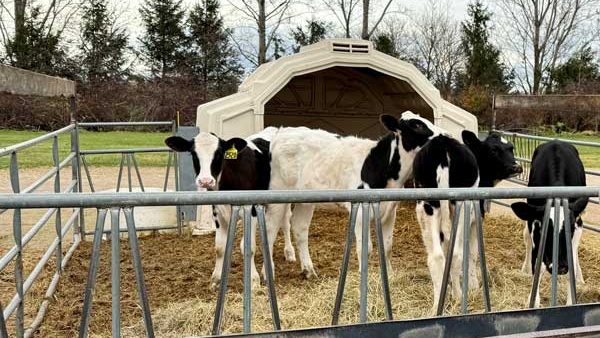
Listen to this article
Calf hutches
Calf hutches are typically constructed from polyethylene or fiberglass, providing shelter from environmental conditions. By minimizing direct contact between calves, hutches reduce the risk of disease transmission. They allow close monitoring of each calf, facilitating early disease detection and personalized feeding strategies when needed. Proper placement of hutches facing away from prevailing winds and adequate spacing prevent contamination between calves. During colder months, deep bedding, often straw, is utilized, allowing calves to nest comfortably and maintain body heat.
Indoor pens
Indoor pens are individual enclosures within a barn or shed, offering protection from weather extremes. While offering a controlled environment, these pens require proper ventilation systems to prevent respiratory health issues caused by inadequate air circulation.
Group hutches or pens
Group hutches or pens accommodate multiple calves in a shared space, promoting social interaction and natural behaviors (Figure 1). Transition housing is employed from the post-weaning period until calves reach approximately six months of age, assisting them in adapting to larger group dynamics and supporting continued growth.
Outdoor vs. Indoor Housing
Providing consistent care, such as feeding and bedding, can be more challenging in outdoor settings, particularly during severe weather conditions. Calves housed outdoors are directly exposed to environmental conditions, such as extreme temperatures, precipitation, and wind, increasing the risk of cold stress during winter. When temperatures fall below a calf’s thermoneutral zone (50°F), the upper vents of hutches are sometimes closed to minimize heat loss, inadvertently reducing air quality.
Indoor housing settings provide protection from harsh weather for both calves and caregivers. However, poorly designed indoor facilities may have inadequate ventilation, resulting in decreased air quality and the buildup of airborne pathogens, therefore increasing the risk of respiratory diseases. Additionally, placing calf hutches directly on soil can result in moisture buildup and muddy conditions, fostering pathogen growth and further elevating disease risks.
Ammonia Risks in Calf Housing
One of the primary air quality concerns in calf housing is ammonia. Ammonia is a pungent, water-soluble gas that irritates the mucous membranes of the respiratory tract, making calves more vulnerable to viruses and bacteria that can lead to infections. It is strongly associated with Bovine Respiratory Disease (BRD), the leading cause of morbidity and mortality in pre-weaned calves [1].
The recommended exposure limits (RELs) for ammonia for workers are an 8-hour time-weighted average (TWA) of 25 ppm and a short-term exposure limit (STEL) of 35 ppm for a 15-minute exposure [2]. However, ammonia can begin affecting calf health at much lower concentrations because calves experience continuous exposure. Studies showed that calves exposed to ammonia levels above 4 ppm were associated with a higher prevalence of lung lesions [3]. It was reported that in general, ammonia levels are desired to be below 10 ppm and, when possible, below 5 ppm [4].

Monitoring ammonia levels
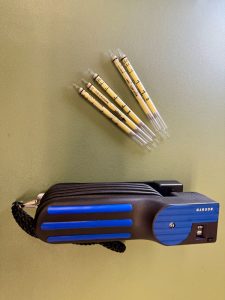
(Photo: Nesli Akdeniz)
Our site visits indicated that ammonia levels in calf hutches or pens typically remain at a few ppm when bedding is well-managed and airflow is adequate (Figure 2). However, it can increase to the 10-20 ppm range in localized pockets or under poor ventilation. If there are concerns about ventilation design, low airflow zones, or ammonia levels, an easy way to measure ammonia concentrations is by using colorimetric detection tubes, which consist of glass tubes containing chemical reagents that change color upon exposure to NH3 (Figure 3). Air is manually drawn through the tube using a calibrated hand pump. The length of the color change within the tube indicates the concentration, which can be read directly from the printed scale. These tubes are easy to use, provide immediate results, and are convenient for quick on-site assessments. Several brands are available for purchase.
The odor detection threshold for ammonia is around 5 ppm, meaning we can often smell ammonia well before it reaches its recommended exposure limits. Although the human nose is sensitive enough to detect ammonia at low concentrations, prolonged exposure can cause individuals to become nose-blind, reducing their ability to notice its presence over time.
Mitigation strategies for improved air quality
Good ventilation
Adequate air exchange is essential for preventing the buildup of ammonia and other airborne contaminants. Outdoor hutches usually provide good ventilation unless the front opening is closed to protect calves from cold weather. Indoor calf barns need to be designed to ensure sufficient ventilation and air exchange. Recommendations suggest a minimum of 4 air exchanges per hour during cold weather. This can be achieved through natural or mechanical ventilation. The goal is to remove ammonia without creating drafts on the calves. In recent years, positive-pressure ventilation tubes have been widely adopted in calf buildings to continuously deliver fresh air at the calf level.
Bedding management
The importance of keeping bedding material dry cannot be overstated. Dry bedding not only provides comfort and insulation for calves but also helps minimize ammonia emissions, as urea in urine must be hydrolyzed to release NH₃, and this process is limited when the bedding remains dry. Many farms use a “deep bedding” or “pack system” for calves, where straw is continuously added on top. The frequency of bedding changes varies by farm. If bedding is not changed often enough, urine and feces accumulate, leading to increased ammonia emissions, while changing it too frequently can be labor-intensive. A common approach is to remove and replace all bedding between batches of calves, but if calves remain in the same pen for more than eight weeks, periodic cleanouts are necessary.
Summary
Maintaining good air quality in calf housing is essential for calf health, especially when it comes to ammonia exposure. Although the human nose can detect ammonia around 5 ppm, studies show that calf health may already be affected at this level. When possible, ammonia concentrations should be kept below 5 ppm through proper ventilation and bedding management.
If you are concerned about ammonia levels in your calf housing, please reach out to Nesli at nesli@wisc.edu to schedule a site visit.
Authors

Neslihan Akdeniz
Livestock Controlled Environments Extension Specialist, Assistant Professor– Mainly focusing on controlled environments for livestock production, also interested in nutrient management and indoor plant-growing facilities.

Jackie McCarville
Regional Dairy Educator – Jackie’s primary focus is dairy operations. She has experience in the private sector in animal nutrition and on dairy farms.
References
- Donlon, J.D., McAloon, C.G., Hyde, R., Aly, S., Pardon, B., and Mee, J.F. 2023. A systematic review of the relationship between housing environmental factors and bovine respiratory disease in pre-weaned calves. Vet J 2023, p. 106031. DOI: 10.1016/j.tvjl.2023.106031.
- NIOSH, 2019. Ammonia exposure limits. Available online: https://www.cdc.gov/niosh/npg/npgd0028.html (accessed on 3-19-2025).
- van Leenen, K., Jouret, J., Demeyer, P., Van Driessche, L., De Cremer, L., Masmeijer, C., Boyen, F., Deprez, P., and Pardon, B. 2020. Associations of barn air quality parameters with ultrasonographic lung lesions, airway inflammation and infection in group-housed calves. Prev Vet Med 2020, 181: p. 105056. DOI: 10.1016/j.prevetmed.2020.105056.
- Bonizzi, S., Gislon, G., Brasca, M., Morandi, S., Sandrucci, A., and Zucali, M. 2022. Air Quality, Management Practices and Calf Health in Italian Dairy Cattle Farms. Animals (Basel) 2022, 12 (17). DOI: 10.3390/ani12172286.
Acknowledgement: We are grateful for the Consortium for Extension and Research in Agriculture and Natural Resources (CERANR) grant provided by CALS at UW-Madison (AAN6651).
Published: April 1, 2025


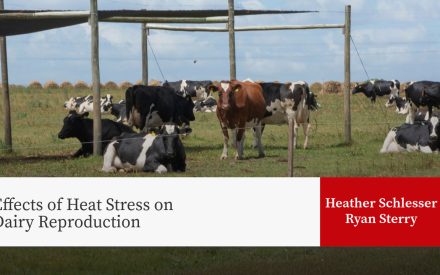 Effects of Heat Stress on Dairy Reproduction
Effects of Heat Stress on Dairy Reproduction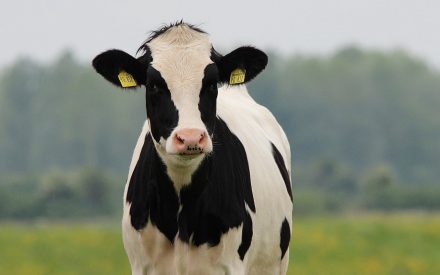 Dry Cow Heat Stress Management
Dry Cow Heat Stress Management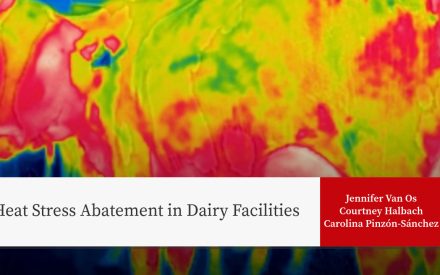 Heat Stress Abatement in Dairy Facilities
Heat Stress Abatement in Dairy Facilities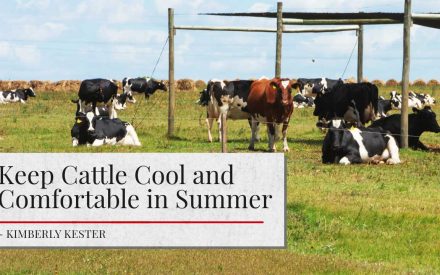 Keep Cattle Cool and Comfortable in Summer
Keep Cattle Cool and Comfortable in Summer


